|
FAQs on Bolivian Rams
Related Articles:
Dwarf South American Cichlids,
Rams, Discus,
Juraparoids,
Neotropical Cichlids,
African Cichlids,
Asian Cichlids,
Cichlid Fishes in General,
Related FAQs:
Rams,
Ram Identification,
Ram Behavior,
Ram
Compatibility, Ram Selection,
Ram Systems,
Ram Feeding,
Ram
Disease, Ram
Reproduction, Cichlids of the World,
Cichlid Systems,
Cichlid Identification,
Cichlid Behavior,
Cichlid Compatibility,
Cichlid Selection,
Cichlid Feeding,
Cichlid Disease,
Cichlid
Reproduction,
|
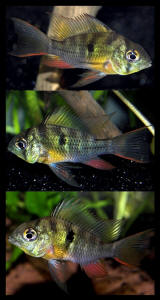
|
|
Bolivian Ram bottom sitting and not eating after being shipped to
me. Pix 4/20/20
Good afternoon, I write to ask for help! Bolivian Ram that I recived 2 days
ago in shipment is not dooing good.
<I would immediately claim this against whatever insurance policy the online
retailer provides. While this fish may recover with appropriate treatment
(i.e., Metronidazole along an antibiotic) and good conditions, it
is in a very bad way. Cichlids do become stressed when exposed to cold, and
can recover if kept properly afterwards. But this fish looks very thin and
dark, so there may be something else going on.>
Fish is sitting on the bottom, not reacting to food and struggles to swim
from time to time with its tail down. Shipping took almost 2 days. My tank
is established for 11 weeks now. I house In it 7 Honey Gouramies, 2
Bolivian Rams, 5 Panda Cory's. It is 29 gallon planted aquarium with
Canister and HOB filtration. I use heater, air stone and LED lighting.
Bolivian Ram that I did recive looks mature, fish is big but I don't know
how old it is?
<Likely 6-12 months old if this is a farmed fish sent out to you not long
after being received by the retailer from the wholesaler.>
Please help me to bring it back to life. Should I use aquarium salt for few
days?
<No.>
Will it help?
<No. Good luck, Neale.>
|
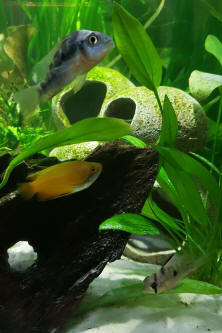
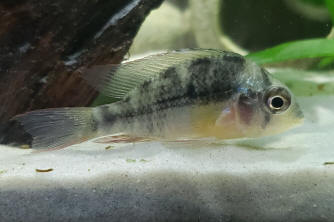 |
|
Re: Bolivian Ram bottom sitting and not eating after being
shipped to me. 4/20/20
Thank you for your response Neale,
<Welcome.>
I've just ordered Metronidazole for fish.
<A good call, and the best general purpose cure for cichlids because they
are so prone to things like Hexamita that only Metronidazole will treat.>
I hope that my Bolivian Ram will make it. There is no chance to get any
response from the farm I did order my fish. I tried already...
<Oh dear.>
I just have one more question about it's gender. I did order boy but this
fish looks like female to me. Can you confirm it?
<Not from your photos, no. This species is quite difficult to sex. Males and
females are almost identical, with only a few differences: males are
slightly bigger, tend to be slightly more colourful, and have slightly
longer fins (especially the tips of the dorsal, anal and tail fins). Beyond
that, younger specimens of both sexes can be easily confused. Cheers,
Neale.>
|
Bottom-sitting Bolivian 10/15/19
Hello
I believe my fish is recovering now, but from what I'm not sure.
<Good to hear!>
In many years of fishkeeping I haven't dealt with something like this and
couldn't find it in any book.
<Indeed?>
Tankmates in my 30 gallon are one Bolivian Ram, seven well behaved Pristella
tetras and three African dwarf frogs.
<Pristella tetras are great, and good companions for the Rams. The frogs are a
bit of a gamble, being tricky to feed at the best of times.>
Sandy bottom, lots of plants and caves. Tank has been cycled for years and water
parameters are 0, 0 , 10 with 7.8 pH and 80* F. Weekly water changes of 25%.
<Sounds fine.>
About six weeks ago my two-year old Bolivian Ram suddenly began bottom-sitting
and spending more time in the back of tank instead of front and center as usual.
No change in color, no clamped fins, remains alert and his appetite good, but
gets around with some difficulty. I target feed him, and tried sneaking in some
kanamycin but he wouldn't touch that. He heartily eats a variety of Spirulina
flakes, cichlid pellets, and occasional frozen-thawed treats however. No
freeze-dried food. The only medicating I've done is Epsom salt for a few days
which neither helped nor hurt. He continued bottom-sitting but got no worse. I
was getting ready to write you when yesterday for the first time in weeks he was
hovering
*above* the bottom and swimming about more. Still not 100% but hopefully he's on
the mend from whatever ailed him.
<Understood.>
Could his swim bladder have been out of order temporarily? Is that a thing?
<Not really, no. While I'm sure swim bladder infections are possible, mostly
it's a symptom, like a runny nose in humans, and not a specific disease. Mostly
when people say "swim bladder disease" what they actually mean is that the fish
isn't swimming properly. That can have all kinds of causes. Constipation at the
mild end of the range, all the way through to genetic disorders and lethal
bacterial infections.>
Usually bottom sitting this long doesn't end well, so it's curious. If he
relapses should I try the antibiotic in a qt bath? Thanks so much for being
here. Your work is much needed and appreciated. Jannika
<If the fish is recovering, I'd be tempted to leave things be. Epsom Salt can be
used safely for as long as you want, and antibiotics, if used correctly, should
be safe. Treating with Metronidazole is another good idea with sick cichlids,
handling the common Hexamita and similar infections better than anything else.
But beyond that, observing and waiting is probably the best bet. Cheers, Neale.>
|
Bolivian Ram sexing with photos
6/11/17
<9,950k....>
Hi crew,
Been a while since I have written. I bought a couple Bolivian Rams from my local
pet store. If I remember from my previous readings, you should not keep 2 males
together.
<Fine if in ratio w/ number of females (like thrice as many to males; IF there's
room for all>
Is this a pretty strict rule of thumb? I bought these on two different days and
"to me" keeping in mind that one has lighter stripe coloring.( I am hoping it's
a female) and the darker coloring is a male. It's a bit hard for me to tell by
the protruding spine that I have read about and of course I could be way off on
that too.
Anyways, I attached a couple of photos hoping they are good enough that you
might be able to tell me at the least if I did get one and one, and if so which
one is which. Photos are labeled fish3 fish4 fish,fish2Or do you need better
photos to tell?
<The latter... but you can tell this from being there:
"1. If the anal fin is more pointed/more defined angles, squarish in shape, then
it's a male. If it's longer and rounder then it's female.
2. The little breeding tube, just in front of the anal fin. Kind of looks like a
little bump. Well, the male has a smaller, more pointed one, while the female
has a larger more rounded one to pass eggs through.
3. The dorsal fin can be a give away too. The female can have a gradual slope,
sloping backwards at the front of the fin. And most males can have a longer
third ray (the spikes in the fin). This isn't always accurate though.
4. Males tend to be larger and more colourful. The pinks and blues brighter, and
the eye spot on each side much more vibrant.
Female Ram. Notice the anal fin. Long and rounded, no sharp edges, not squarish.
Male Ram. The anal fin is sharp and made up of angles, squarish. And not
elongated.
Male Ram. See the breeding tube, in front of the anal fin? The little bump? It's
smaller and pointy."
PLUS read here:
http://www.aquaticcommunity.com/aquariumforum/showthread.php?t=92214
Thank in advance, Joe Kerner
<Going forward, sharper (better resolved), CROPPED images please. Bob Fenner>
|
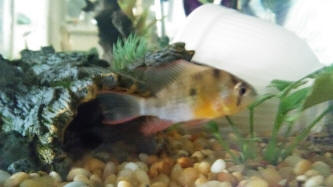

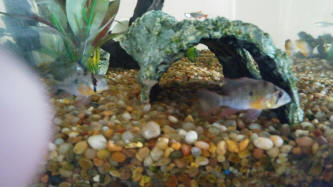
 |
Diff. Ram species not getting along 3/17/17
I have 2 male 1 female Bolivian Rams and a male German Blue ram in the same tank
it seams the German Blue ram is being aggressive towards the Bolivian Rams any
advice what to do
<I'd remove the Blue Ram to elsewhere. UNLESS you have enough room here, there
will be only further trouble. Bob Fenner>
Male Bolivian rams digging... /RMF
10/13/15
Hello,
<Abdullah>
My question is regarding the behavior of Bolivian rams. All the material
I was able to access on your site as well as
the web seems to indicate that digging a
spawning site is an action that occurs prior to spawning and by
the female mostly.
<Yes>
There seems to be the implication also that this occurs
after a pair is formed.
<This is so as well>
I have 2 male Bolivian rams and a male ramirezi is the same tank. Tank
temperature is constant at 26 degrees Celsius and the tank also
houses harlequin Rasboras, lamb chop Rasboras,
Ancistrus albinos (Bristlenose catfish) and 2
albino cories (aeneus albinos, not paleatus based on body
and fin shape). The males chase each other around from their
territories but there are no injuries.
<Good>
Today when I came from the weekend, I noticed a huge crater in the
middle of my aquarium about 4 cm deep. I had
read about spawning behavior of Ramirez's and
rams and so I was surprised when I saw this. I apologize for
the long write-up, but my question is: is it possible that a male
ramirezi or ram dug up this spawning site
singly and without a female present, or is it
more likely that one of the "males" is actually a female?
<Either is a possibility... Males of both species do "just dig" at
times.
Perhaps this is a food-seeking as well as reproductive behavior. Bob
Fenner>
Male Bolivian rams digging... /Neale
10/14/14
Hello,
<Greetings.>
My question is regarding the behavior of Bolivian rams. All the material
I was able to access on your site as well as the web seems to indicate
that digging a spawning site is an action that occurs prior to spawning
and by the female mostly.
<Hmm... not really. Both sexes may dig a bit, but spawning normally
happens on flat stones and other smooth surfaces. Will vary, depending
on what's in the tank.>
There seems to be the implication also that this occurs after a pair is
formed.
<Somewhat. Both sexes look after the eggs and fry, as is usually the
case where males and females look very alike.>
I have 2 male Bolivian rams and a male ramirezi is the same tank. Tank
temperature is constant at 26 degrees Celsius
<Not ideal for the Common Ram cichlid.>
and the tank also houses harlequin Rasboras, lamb chop Rasboras,
Ancistrus albinos (Bristlenose catfish) and 2 albino cories (aeneus
albinos, not paleatus based on body and fin shape). The males chase each
other around from their territories but there are no injuries.
<Good.>
Today when I came from the weekend, I noticed a huge crater in the
middle of my aquarium about 4 cm deep. I had read about spawning
behaviour of Ramirez's and rams and so I was surprised when I saw this.
<Indeed. Not uncommon, but they prefer to lay their eggs on a suitable
flat stone somewhere quiet. But failing that, yes, they will make
spawning pits.
It isn't uncommon for male cichlids to make these pits as a way of
attracting the female. So while what you see isn't normal, it isn't
unusual either.>
I apologise for the long write-up, but my question is: is it possible
that a male ramirezi or ram dug up this spawning site singly and without
a female present, or is it more likely that one of the "males" is
actually a
female?
<Well, it's true that sexing Bolivian Rams isn't easy! But usually, the
male is a bit bigger, a bit more colourful, and has fins (especially the
dorsal and anal) that are a bit longer than those on the female. On the
other hand, they tend to form pairs easily enough, even in the tropical
fish shop! So observing behaviour should be a good indicator what's
going on. In short, sit back, observe, and wait and see what happens!
Cheers, Neale.>
Mixing a Bolivian Ram and Apistogramma 10/5/13
Hi crew,
<Dunc>
Thanks for reading my email.
<Sure>
Is ridiculous to think that a single, reasonably-tempered Bolivian Ram
could share a 3ft, 180L community tank with 1m and 2f Apistogramma
agassizi, assuming enough hiding spots (caves, wood), moderate planting
(Vallisneria, java fern, Amazon sword and floating Frogbit), temp 28 deg
C, GH/KH 3-4, pH 7.2ish and Nitrogenous waste where it should be (0, 0,
<20)?
<Not ridiculous. I'd bet they'd cohabitate>
One 20% water change per week/week and a half is carried out.
<Mmm, every week if you have the water>
There's a male Apisto in there as of today - a bit of ram chasing Apisto
but nothing serious yet - I will monitor.
I'd love the look of the bulky Ram co-habitating with the dainty Apistos
if possible.
I have removed a male P. taeniatus already, as though he went pretty
easy on the ram for a year, I think I'd be pushing it with anything
else.
Other tank inhabitants are:
- 19 x Cardinal Tetra (who fin-nipped my Pearl Gourami into another
tank!)
- 1 x Bristlenose Ancistrus (a bit feisty) - would this eat eggs/fry of
the proposed cichlid harem?
<Might>
- 1 x female 3-spot Gourami (generally well-behaved)
- 3 x Amano shrimp (big, healthy)
On another note, could two pairs of different Apisto species (agassizi
and
trifasciatus) share this space - a possible future project.
<Should be able to fit in two pair of this genus in this size, shape
tank>
Cheers and thanks!
Duncan.
<Welcome, Bob Fenner>
Mixing a Bolivian Ram and Apistogramma 10/5/13
Hey crew, not sure if the below made it through from Thurs night., so
I've included it below.
<Ah, did. I just "saved" overnight, hoping Neale (in the UK) would pick
up.
BobF>
Thanks!
Duncan.
Re: Mixing a Bolivian Ram and Apistogramma /Neale's further
input
10/5/13
<<I don't disagree with Bob, but would caution you that -- as
always with cichlids -- there are no guarantees so far as social
behaviour goes!
Despite being much bigger, a single female Bolivian Ram should not be
much of a threat to a pair of robust Apistogramma such as A.
cacatuoides, but a male (or worse, a pair) of Bolivian Rams might be a
"real and present danger" to any Apistogramma kept with them in a small
aquarium. On the whole Apistogramma tend to occupy smaller territories
towards the back of the tank, while Bolivian Rams are much bolder fish
that hang about at the front of the aquarium, so with luck they'll
largely ignore each other if the tank is adequately large and well
decorated with things to break up lines of sight. Mixing Apistogramma
species works well, assuming the species chosen share similar
requirements (there is some variation re: temperature for example) but
you do of course run the risk of hybridisation. Finally, I would not mix
any dwarf cichlid with Loricariid catfish if my goal was rearing fry.
While cichlids generally make excellent guardians by day, they are
almost blind at night, and that is when catfish will view their nests as
prime feeding grounds! There's a suggestion that some cichlid species
move eggs from one nest to another precisely because this makes it
harder for catfish to find their eggs, and it's only a small step from
moving eggs by mouth to become true mouthbrooders, which is an even
better way to keep their eggs safe. Cheers, Neale.>> Ram pair/ Angelfish with issues.
8/11/13
I have good news and bad news, The good news is I traded the old pair of
Bolivian rams, the female was thin and the male kept on beating her and
vise versa. the new pair I got for free because I had paid for the old
pair and they were in better shape ( the female) then when I got her..
The new pair/ is much healthier / swims side by side and seems to be
hitting it off much better then the last pair did.. A employee at my
fish store told me they will pay me in cash for any babies if I get any.
How many babies can Bolivians make per spawn?.
<As with other South American dwarf cichlids, around 100 eggs are laid,
though unless you pull the eggs and rear them yourself, you won't end up
with anything like that number of juveniles. Left to themselves, Rams
will likely rear around 20-40 offspring. A lot depends on water quality
in the tank (nitrates need to be near zero for highest numbers) and the
amount of suitable food offered (4 meals minimum, 6 ideal, of small live
foods like brine shrimp nauplii).>
Sadly Marbelloh seems to be getting pop eye. I think he may have came
like this or gotten it from the stress of shipping to the new tank from
the dealers/ect. Sense I have the pair of rams in the tank- I only have
1 tank set up now I was wondering if medicated flakes from Aqua land
will help the condition.. What should I do. He seems to be actively
swimming around the tank with fins flared- interested in his
surroundings but has one eye that is swollen..
Should I test the water? I did a water change earlier this morning.
<As Bob would say, read/search WWM before writing; all this has been
covered before. Start here:
http://www.wetwebmedia.com/fwsubwebindex/SaltUsePopEyeF.htm
Cheers, Neale.>
|
Bolivian Ram in distress (continued) and additional questions
to Neale f' 8/3/13
Hello again, Crew!
<Mmm, BobF here; Neale's out. Will respond and place your query in his
in-box>
I promised that I'd respond and let you know how all came out
a few months ago, so am writing to do so, along with more questions - of
course.
I wrote in back on 5/28/13 with questions about a Bolivian Ram in distress,
see here:
http://www.wetwebmedia.com/BolivianRamF.htm *
<Ah yes; I put all away/parse>
*(thank you once again Neale, for your help with this)
I had to wait a week for the shop to get Nitrofurazone in, so I went ahead
and treated the entire tank with a medication that included both
Metronidazole and Praziquantel. Nothing changed during treatment, but a few
days after, the sole affected Bolivian Ram stopped eating, at which point I
moved him into a QT tank (fully cycled) and treated him alone with
Nitrofurazone. I noticed when I moved him that the skin around his gills had
gone black. He did begin eating again, after treatment, but continued to
have much difficulty with breathing, and the blackening spread quickly,
until his death. I did 50% water changes in the main tank daily for several
weeks, but none of the stock in the main tank showed any similar symptoms,
and things went back to normal.
I have uploaded images of the sick fish taken after his death that fairly
clearly show the blackening around and under his gills, and am wondering if
these can help you confirm a diagnosis for me, and let me know if there is
anything else I should do in my main tank to ensure that this illness is
treated and gone - I would hate to see it return, if at all possible.
http://i677.photobucket.com/albums/vv135/HuginnMuninnandMe/HuginnMuninnandMe001/BlackRam1_zpsb7c628b5.jpg
http://i677.photobucket.com/albums/vv135/HuginnMuninnandMe/HuginnMuninnandMe001/BlackRam2_zpsfc7430bd.jpg
http://i677.photobucket.com/albums/vv135/HuginnMuninnandMe/HuginnMuninnandMe001/BlackRam3_zpsfaf0d732.jpg
http://i677.photobucket.com/albums/vv135/HuginnMuninnandMe/HuginnMuninnandMe001/BlackRam4_zps546f7db7.jpg
http://i677.photobucket.com/albums/vv135/HuginnMuninnandMe/HuginnMuninnandMe001/BlackRam5_zps713aef5e.jpg
<Mmm, was going to guess/speculate (so I will) that the treatment itself is
likely the root cause of trouble here; that maybe internal/lumenal parasites
killed off in turn resulted in the fish's loss; but looking at your pix...
Appears that the gills themselves were destroyed, and/or the blood of the
fish. Should be light pink; not black>
That's the FIRST question. . . I have another.
In this tank lived 9 Pangio cuneovirgata, and 5 Pangio Kuhli. The P
cuneovirgata were introduced to this tank in January 2013, after a 2 month
QT period, and the P. kuhlii have been in there for about a year and a half
now. Just before the Bolivian Ram started showing symptoms of illness, one
of the P. cuneovirgata lost his barbels. None of the other loaches in the
tank showed any similar symptoms, and the affected fish continued to eat and
behave as normally. I assumed perhaps that it was due to a bacterial
infection caused by the substrate digging that the rams had been doing while
brooding,
<Very common to "lose barbels" from substrate rubbing period. Loaches really
need fine sand... smaller Cobitids even finer>
and upped my water changes, but
to this day he is still missing his barbels.
<IF worn and/or chemically, biologically "burned" back too far they
won't/don't regenerate>
I may have lost 2 of these dwarf loaches in the meantime, I only seem to be
able to count 7 - but they can be so difficult to count. I can't tell them
apart from one another, so it could be that this is simply affecting one
fish at a time, though that seems unlikely.
<Is unlikely>
Whichever it is, I still have one, and only one, barbel-less loach in this
tank. In the meantime, I have other P. cuneovirgata who have been in QT for
several months now, and I would like to move them into the main tank, but I
am very leery of doing so until I am sure that the issues in this tank are
resolved. Here is an image of the sole affected loach:
http://i677.photobucket.com/albums/vv135/HuginnMuninnandMe/HuginnMuninnandMe001/Barbelless_zpsa3d55c75.jpg
All of the animals in this tank are behaving normally, coloration,
breathing, eating - all seem normal. I'm completely at a loss!
<I'm not... See WWM re Loach Systems (FAQs)>
As always, I am very grateful for any input or advice you can offer.
Thank you so much for your time!
- Chesh
<Cheers, Bob Fenner>
|

 |
|
Re: Bolivian Ram in distress (continued) and additional
questions 8/4/13
<<Since both the Ram and the Loaches are bottom dwellers, I'd be looking
at the state of the bottom one-third of the aquarium. Specifically,
check two things. Firstly, that there's a good strong current moving
along the bottom. If there isn't, then oxygen from the air/water
interface isn't likely to get down there, and that will cause severe
stress of fishes living at the bottom of the tank. Some fish (Corydoras,
Plecs, etc.) will swim up to the top and gulp air, and they do this in
the wild under precisely these sorts of conditions, so they may not show
symptoms of stress. But cichlids especially lack this behaviour, as do
those Loaches adapted to clean, clear streams where oxygenation is
normally very high (Hillstream loaches, Botiine loaches, etc.). As Bob
mentioned, black gills are deeply unhealthy gills, though whether this
is because of anoxic conditions at the bottom of the tank or some
parasitic infection is hard to say. Secondly, as Bob also said, the
substrate can be a problem. Smooth silica sands (pool filter sand,
gardener's silver sand) are optimal and in many ways easiest to keep
clean. If you must use gravel, choose a very fine pea gravel with no
sharp edges. Loaches losing their whiskers is a good clue the substrate
is wrong, either through bacterial infection or abrasiveness. Hope this
helps, Neale.>>
|
|
Bolivian Ram in distress
5/28/13
One of my Bolivian Rams (out of five in this tank) is showing signs of
distress. He is breathing laboriously, pumping his gills very hard
without resting. I am including a link to a 40-second video of the fish,
as his behavior can explain his symptoms far more easily than I can with
words :)
http://www.youtube.com/watch?feature=player_detailpage&v=SuRlM8Cl1SM
The tank is a 55 gallon, well planted, freshwater community. Stocking
includes: 5 Bolivian Rams (2 male), 5 Pangio Kuhli semicincta?), 9
Pangio cuneovirgata, 18 Jelly Bean Tetra (Ladigesia roloffi), 1 (well
fed) African Dwarf frog, as well as Nerite, and a host of Malaysian
Trumpet snails. This tank was set up in September of last year, but this
fish along with some of the others were transferred in from a previously
established 29g setup.
Water parameters are fine, and have remained stable. Tests done today
using the API Master Freshwater test kit are as follows; 0 ammonia, 0
nitrites, 0 phosphates, and around 7.5 nitrAtes. Ph is 7.2, KH 3 and GH
7 DGH.
<All sounds fine.>
The temperature in this tank hovers right around 79f,
<Would knock this down a notch; 25 C/77 F is ideal for this mix of
livestock.>
lights are on for 8 hours daily, and the tank is covered at night. I use
an EHEIM Classic external canister filter rated for up to 92 US gallons
on this tank, and the flow is baffled, so there is no strong current to
disturb the fish. This tank gets a water change of between 30-50%
(typically 50%) weekly, and I do siphon visible detritus from the
substrate when I clean. I have always used tap water in my tanks, and
treat the water with Seachem's Prime to remove chlorine and chloramine.
I clear my filter about once every 3 months, at the longest. This has
been my routine for over a year now in caring for all of my tanks.
<Cleaning the filter a bit more frequently would be a plus, maybe twice
as often, but if your water quality is good, you may not feel the need.
Bob F recommends frequent filter cleaning; I tend to leave filters alone
if they're working and water quality is good -- different aquarists have
different takes on this, and to some degree it's about experience and
"feel" for your aquarium.>
There has been no unusual activity near the tank this weekend that would
cause stress, nor have their been any chemicals or contaminates in my
home.
My fish are fed daily with a mix of New Life Spectrum foods (both
sinking pellets and flake) as well as wet-frozen goodies - various
shrimp and worms. He is still eating well enough, and the rest of the
tank seems very healthy, and is behaving normally. I did a 50% water
change right after I saw that he was having trouble, but saw no change
after in his behavior.
<A good idea to do this water change.>
This particular fish has a history. When I brought him home about a year
ago, I contacted you guys with a concern about his health. (see here:
http://www.wetwebmedia.com/BolivianRamF.htm
"Skinny Bolivian Ram - sickness?" Letter dated 5/24/2012) He was eating
well, but not gaining weight. After about a month or so in my tank, he
was thinner than when he had started. The other fish remained well.
Eventually I moved him into a QT tank, and treated him alone with a
medication that included both Metronidazole and Praziquantel. I gave him
these medications both in the water, and mixed in with his food, and he
recovered fully. Once he had gained weight again, he was returned to the
community, and he has remained since with no issues. He is actually one
of a bonded pair of rams that has been spawning more or less every month
since the beginning of the year.
<I see.>
I introduced the dwarf loaches into this tank about 4 months ago after
keeping them alone in QT for a period of 2 months. Nothing has been
added or changed in this tank since then. I QT everything (including
plants and snails) that is introduced to this tank, but I do not
medicate livestock in QT unless they show symptoms of illness. A year
ago, when this fish was added, I did not know to QT, and he was sick. So
it is possible that whatever this is has been in the system for quite
some time, or that it came in with the addition of the loaches.
<Could be either, but do also remember many problems are opportunistic,
in other words, the pathogen lies dormant in most/all aquaria, possibly
harmlessly as part of the aquarium ecosystem of microbes, but something
happens that causes this pathogen to infect your pet fish and cause
harm.>
The only other thing that I can think of that could apply is that a few
months ago, I saw two of my rams flashing. They flashed several times
over the course of a few days, and I haven't seen this behavior repeated
since then. Otherwise I can see no other abnormal symptoms on this or
any of the other animals in the tank. Any and all input or advice you
can give me into how to handle this situation will be very much
appreciated!
<No obvious problem here that I can see from your aquarium parameters.
If this was poisoning, I'd expect multiple fish to be stressed, and
there's nothing obviously amiss with the environment or stocking. My gut
feeling is that this is simply a weak, sickly fish and always has been,
and likely needs another course of Metronidazole, ideally alongside a
robust antibiotic such as Nitrofurazone, to give it the best chance of
recovery. I don't think worms are an issue, so Praziquantel may be
unnecessary, but if you want to use it too, then go ahead.>
Thanks, as always,
- Chesh
<Welcome, Neale.>
Re: Bolivian Ram in distress 5/28/13
Thank you for your swift reply, Neale. It is appreciated more than you
know. . .
<Glad to help.>
I will try treating this fish with Metronidazole, as well as
Nitrofurazone, as you have recommended. At this point, I'm leery of
putting him through the stress of a move into a QT/hospital tank - I'm
afraid that might just seal his fate.
<I agree, and these two meds are relatively benign.>
Though I suspect I'm wrong in this, I'm feeling inclined to go with my
knee-jerk reaction to treat the entire tank in an attempt to get rid of
whatever this may be once and for all. Wondering if this combo of meds
would cause any harm to the loaches, tetra, plants, and snails if I were
to treat the entire tank, instead of moving this one fish?
<All should be fine, but keep a close eye on all.>
I will definitely try dropping the temps back just a bit, as you
recommended, also - thanks for that input.
<Welcome.>
I'm suspecting that this was perhaps brought back out by the stress of
attempting broodcare in a community tank, of course it's impossible to
know for sure. Poor little fish! I just hope that I am able to bring him
back to health.
<Time will tell, but you're doing your best, which is the important
bit.>
Thanks again for your input, as always!
- Chesh
<Good luck, Neale.>
|
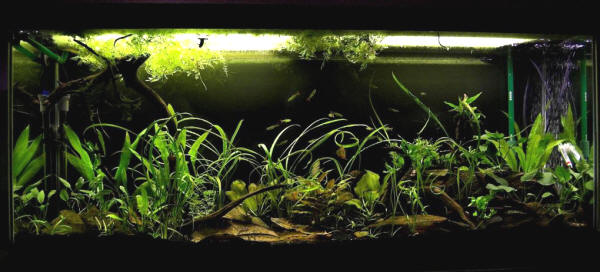 |
|
Re: Bolivian Ram in distress 5/29/13
Once again, words can't express how much comfort I take in having your
mind and experience to help me along in situations like this. Thank you
for all you do.
<Thanks for the kind words.>
As usual with me, just as I feel I've gotten everything settled in my
mind, I manage to come up with a few additional questions. . . I've
managed to track down both of these meds locally this time, and with no
additional drugs added, so huzzah for that. I plan to begin treatment
tonight after work. Questions are these:
Would there be any point in starting these meds at a lower dosage to
check the effects on the other fish in the tank,
<No.>
or to begin using one before the other
<No.>
for the same reason and so that I can isolate which med might be causing
stress to the OTHER animals in the tank, if it proves to be of concern?
<Do medicate as instructed on the packaging, remember to remove carbon
from the filter, up the aeration/circulation if possible, and keep a
close eye open for signs of stress, such as extreme nervousness or
gasping at the surface.>
Or should I just hit them with the full dosage and all at once because
time is obviously of the essence?
<This would be my preference.>
Should I also treat the FOOD with Metro, or is treating only the water
in this case enough?
<Ah, food is the better, if you can get dosage right. But there's
mileage to treating all fish simultaneously, in which case treat the
tank/water.>
Should I go with the dosages per package directions, or is there a
specific Mg/gallon that is my target, aside from the label on the
bottle?
<Would go as instructed unless you have veterinarian advice to the
contrary.>
Finally, though this does not apply directly to the situation. . .
regarding QT procedures, I have my QT tank set up as a miniature version
of the main tank, and have always left new fish alone and untreated in
QT for a period of *usually* 8 weeks, depending on the species,
behavior, and any issues that I see in that time-frame. The idea is to
give them a very comfortable place to de-stress from their travels, and
adjust to my water, and the way I maintain my tanks. I am aware that
many others QT with the proverbial 'guns blazing' and put their animals
through various courses of treatment, regardless of symptoms (or, in
most cases, a lack thereof).
<Definitely worthwhile with some groups of fish especially: Discus,
Loaches, L-number catfish and Puffers, species that can be delicate
immediately after import and/or difficult to treat in display tanks
using standard medications.>
All of this has me wondering what your recommendation is for future QT
situations. IS it best to medicate new arrivals, since most pathogens
are opportunistic?
<Quarantining makes a lot of sense. You can confine inbound parasitic
infections such as Whitespot and Velvet, and you can also make sure new
livestock is feeding properly and otherwise healthy before throwing it
into a community tank where such observations may be difficult to make
(or react to). On the other hand, even in a healthy aquarium there are
bacteria such as Aeromonas and Pseudomonas that can potentially cause
harm (classically, Finrot) if something goes wrong even though most of
the time these bacteria are unable to breach the fish's own immune
system. In short, quarantining fixes/prevents many problems, but not all
of them.>
I'll leave you alone now to help all of the others who need your time.
Thanks again for helping me out, I'll be back in touch after all of this
is done and over - hopefully with happy results - in the hopes of
helping others that find themselves in a similar situation. Again, thank
you most sincerely, your input is invaluable to me.
- Chesh
<Most welcome, Neale.>
|
20 gal long tanks
Moving Tanks - 10/21/2012
Hello I have two twenty gallon tanks with a stand that has one on top
and one on the bottom, I have had these tanks for 12 -13 years., We have
to move the tanks about 4 feet for new carpeting. I need to know if it
is possible to drain each tank half way and have two or three strong
men, lift entire stand not touching tanks STRAIGHT UP about 3 inches
onto a flat dolly, WOULD this be okay to do as I have old fish that I
don't want to stress in putting them in bucket or netting them, one of
them sort of flips out when I touch him with a net, he is almost blind
and loves his space not being disturbed. I really need to know if this
can be done a few feet, it will remain on flat dolly until carpet is
done, then moved back and lifted straight off onto a flat board for
stability??
<I would not recommend this. Instead, I would suggest draining
both tanks to about five gallons - you can save the water in buckets,
just siphon it off slowly. Take the opportunity to clean the
gravel thoroughly using a gravel siphon tube as well, as moving the
tanks WILL disturb any detritus in the substrate, no matter how careful
you are. Then move each tank, fish included, off of the stand and
directly onto the flat dolly (or other nearby flat surface) and then
deal with the carpet, move the stand back in, and replace the tanks on
the stand, fill them again slowly and carefully, and you're set.
You'll still need a couple of big strong guys anyway, as even with just
five gallons or so, these tanks will still be heavy with all their
gravel and such.>
I know they should be all taken out and substrate removed and water out
etc,
<You can move them with substrate and all still in them, but DO remove
any large rocks or decor items that might shift or fall and strike the
sides.>
but we had this idea and want to know if anyone has ever done this, the
tanks will not be disturbed, they wont lean, be moved with handling in
anyway, only the tank stand, and two people will be supporting top tank
until lift is over.
<It might sound good in theory, but there will ALWAYS be unexpected
problems. The route you propose has lots of potential for things
to go wrong. Each tank, half full, is going to weigh somewhere in
the neighborhood of 100 pounds. If the stand starts to tip, it's
going to be harder than expected to prevent. Moving each tank
individually, with just enough water to keep the fish wet, is a much,
much safer option, for you, for the guys moving the tanks, and
especially for the fish. Oh, and DO have an emergency backup plan
if something goes horribly awry - perhaps have one of the buckets of
water easily at hand, just in case you do need to immediately scoop up
any fish that jump out or get inadvertently spilled, or if, Gods forbid,
a tank gets dropped. Just be prepared for the worst, and hopefully
things will go perfectly and the preparations will be unnecessary.>
Thanks
C. Hart
<Good luck with the move and the new carpet, enjoy! -Sabrina>
Moving Tanks - II - 10/22/2012
Hello again, I do understand all you said and I will have their water in
each container near for emergency, I wanted to clarify one thing and
maybe you'll think it is not to bad an idea, the stand is one of
traditional type, some sort of black steel with welded areas to keep it
together made for two twenty tanks, they would be lifting it from the
bottom of top tank, the frame has one tank on bottom and one at top, the
top has the bottom of its area , this is where they would lift it
straight up 2 inches, I would remove all from hanging (filters, etc)
drain to about 5 gallons, and they would lift onto flat dolly , about 3
inches from the bottom of the tank.
Does saying they will be lifting it from center (bottom of top tanks
frame area) make it a little safer or not?
<I would still move the tanks separately from the stand.... but
I'm no physicist. I do genuinely feel that it would be safer
to move the tanks separately, as you're talking about a lot of weight
distributed in such a way that really only two people will be able to
lift it, and should one slip, well, both tanks would be at risk.
Moving them singly will lessen the chance for damage, I think. And
you can still move them onto a dolly, right next to them. Either
option will be equally stressful for the fish, and I do think the fish
will deal with that stress just fine, as long as you monitor water
quality closely for a couple of weeks after the move to be sure the
biofiltration is still happy.>
Thanks again
I've been dealing with this since February when we then decided not to
get carpet, but now are for sure!
<Congrats! I hope it goes well and turns out nicely.>
Cathy Hart
<Best wishes, -Sabrina>
Moving Tanks - III - 10/22/2012
Oh thanks you so much.
<You're very welcome.>
One more thing, my tanks are old, if they are lifted and they do what
you suggested, first can the break easier then with my idea, they have
areas of less silicone at some seams then others, no leaks I just
noticed it one day
<Either way, just have the folks doing the lifting try to keep the tanks
pretty level and not to torque them.>
and secondly would it be okay for one of the fish I have about 12 inches
to be in 5 gallons of water?
<Not knowing what kind of fish it is, I can't really say. But,
what 12 inch fish is in a 20 gallon tank? Is this move something
you could use as a great opportunity to upgrade tank size? Best
wishes, -Sabrina>
Sorry another question
Bolivian Ram Cichlid Groups, comp. 7/13/12
We have one Bolivian Butterfly ram and were thinking of getting him a
couple of friends, will 3 males (no females ) together be ok or will
they fight?
Rebecca James
<Usually Bolivian rams are not too bad on each other. They will set up a
territory and then chase others away when they enter that territory.
Just make sue they have enough aquascaping to define their areas.-Chuck>
Re: sorry another question
Bolivian Ram Tankmate 7/15/12
Thanks Chuck, So really then it wouldn't be like getting a couple of
friends for him as such, seems maybe he might like the tank for himself
better (there are other fish in the tank, and he loves the clown loaches
just thought he might like some of his own kind)? Rebecca
< It is not like they are social and need friends. He will inter act
with other fish that get in his way. When the clown loaches get big he
will be the one being pushed out of the way.-Chuck>
|
Skinny Bolivian Ram - sickness?
5/24/12
Hello to all of you beautiful fishy friends! I love your site and I've
learned so much here - and the advice I've gotten from you in the past has
proven invaluable. Now I find myself in trouble again, and I just can't
trust any of the advice I've been given! I'm hoping that someone might be
able help me diagnose and treat (if necessary) one or all of my little
Bolivian Rams. I'm not sure if this is a disease yet, so I apologize if I'm
pestering you over nothing.
I'm fairly new to aquaria, and these are my first Cichlids. After loads of
research, I brought 4 little Bolivian Rams home 2 weeks ago. They settled
right in, and all have grown a bit and plumped up since coming to live with
me - all except one, and he's the one that I'm worried about!
Image
He's so skinny! Poor little thing. . .
All of them are about 1.5 inches long - from tip to tip - but this one has
been my 'runt' since day 1. He's slightly smaller than the others, and at
the bottom of the newly-establishing hierarchy. Aside from his scrawny tummy
and small size, the only other thing that sets him apart from the others is
that his stripes are very obviously darker. I've read that this can be a
sign of stress, or simply his way of letting the bigger fish know that he's
submissive.
<Yes>
Otherwise, he swims with the others, scraps with them at
mealtimes, and eats well. There is no hiding, flashing, heavy
respiration - he behaves in EVERY way like the other three, and isn't being
targeted or picked on any more than the others as they establish their
territories. All four fish are very social and friendly toward each-other
for the most part. I feed my whole tank a combination of flake food (which
they all eat with no problems), and many different types of wet-frozen
foods, including: bloodworm, Mysis, krill, brine, Daphna. . . I also
regularly toss in blanched veggies - so I don't *think* that this is a
nutrient deficiency - at least not one that he's gotten since he came to
live with me. I've been
watching for feces, but haven't been able to catch him in the act, so to
speak, so I have no idea about that. As for his vent. . . I can't even see
it (assuming this one is a male?) - but there definitely aren't any visible
worms there.
For reference, here are images of the other three, not so skinny BRs. .
. (There are 3 attached images of each fish)
<Nice images>
The coloration on these photos has been intensified because I used the
camera's to get very clear shots of all four of them. You can see that their
tummies are rounded. Their vents are also really obvious - so I'm assuming
these three are females? (feel free to let me know gender, if you can - I'm
really curious about this, too!)
<Mmm, likely so>
Zoom in (real dimensions: 983 x 543)Image
Here is an image of the tank where they live , that will show you more
truthfully their actual coloration - and below a crop from the image above -
my scrawny stripey guy is on the far left below:
<Very nice>
This is a fully cycled 29 gallon TALL tank. Ammonia, nitrite, phosphates all
at 0, and nitrate hangs around 2.5ppm. PH sits at 7.6, GH is 6, and KH is
super low at 2dgh, temperature is usually between 77-78f (too low for rams?
<Should be fine>
I'm reading a HUGE range in the possible temps for this species - are you
able to narrow this down to one ideal temperature?).
<Mmm, I'd raise this... the low 80's F. is better all the way around>
I have a 10g hospital tank that I can move him into if he needs to be kept
on his own for a while. Parameters in the 10g are *almost* as stable as in
the larger 29g, so he will be comfortable and safe there.
Thanks in advance for reading, and for any help and advice you can give me
to keep this little guy (and his buddies) healthy and thriving. I look
forward to hearing what advice you can give me!
Sincerely,
- Jes
<I'd add a good small pellet (Hikari or Spectrum) or sub. this for the flake
food... and likely discontinue the Bloodworms/Chironomid larvae (some issues
in recent years, cited on WWM)... Otherwise leave all in place. The one fish
might have lumenal parasitic issues, but better to wait at this point,
rather than treat all for. Bob Fenner>
|

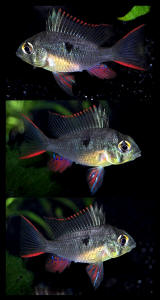
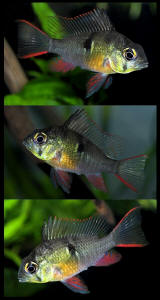

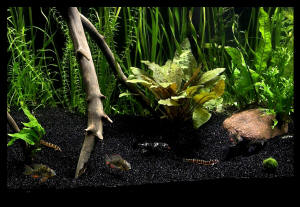 |
Re: Skinny Bolivian Ram - sickness?
5/24/12
Thanks for the quick reply. I'll raise the temp a bit and add a pellet food,
and look into the info you guys have on discontinuing the bloodworm. . .
<Ah good>
but he does eat well. So I'm still confused as to why this ONE out of
THREE is so concave about the stomach?
<Could be for what you/I've stated previously... perhaps lumenal parasitic
involvement; but I wouldn't treat (all) just yet for>
After 2 weeks,
the others have all plumped up - can you give me any clues as to why this
one hasn't? It seems odd to me, but as I've said - I'm new to this!
Research without actual experience only can take one so far. . . Could it
have something to do with him being a male among 3 females?
<Perhaps>
Also. . . after following the advice that you've given, should I expect to
see him start to fill out - and how long do you suspect this would take?
<Weeks, months...>
Or should I expect a male Bolivian to be shaped so, while the females are
not? I don't want to worry if there isn't anything to worry over, but I also
don't want to miss anything that could indicate that this is more serious
than a simple feeding issue.
Thanks again for your time, it is very much appreciated, and I will follow
your advice!
Have a happy day!
- Jes
<Not to worry. BobF>
Re: Skinny Bolivian Ram - sickness?
5/24/12
Oooh! I know you're getting sick of me! I promise I'll go away as soon
as I understand! I've been prowling around WWM trying to find what you
were speaking of regarding bloodworm! I do feed the wet frozen, not live
or freeze-dried. . .
<I'd severely cut back, or eliminate altogether>
Found this from Chuck - is THIS what I was looking for?
"Since I have been working on this website I have noticed that many
aquarists with these problems feed blood worms. I have heard from fish
nutritionists that blood worms themselves are a fine food. The problem
is that they may absorb toxins or bacteria from the mud that disrupt the
intestinal flora and fauna and may cause these problems. There are
plenty of fine commercial flake and pellet foods so I would try to avoid
the blood worms and see if it makes any differences. -Chuck"
<A good example, yes>
To be sure I understand - There is a possibility that associated
toxins/bacteria from feeding bloodworm (which I do in a large rotation
with other foods) could be somehow blocking his ability to absorb
nutrients from the food he is eating - thus causing him to be thin? If
so. . . could this also be true from any of the other wet frozen foods I
feed them? (krill, brine, glassworm, Mysis) Should I stick to pellets
and flakes ONLY - with added veggies?
<I'd just take out the bloodworms>
Also, if I'm understanding correctly, there is the possibility of a
parasite problem. But you don't want me to treat for that until/unless
it gets worse -
<Mmm, actually... if it persists>
or there is proof positive of a condition. This makes sense . . .My
understanding is that many types of parasites are normally found in
fish, but cause no problems until stress weakens the fish, giving them a
foothold (right?!).
<Yes>
That said. . . if he does have a parasite, but starts to plump up anyway -
I should not be concerned with said parasite because it isn't affecting
his health? And if it does turn out to be parasitic in nature, will I be
required to treat the entire tank, or just the fish showing symptoms in
the QT tank?
<Best to treat all; via foods>
Are there any other signs or symptoms that I should be keeping an eye
out for that would indicate a worsening in his condition other than the
obvious 'normal' fish indicators? These are my first Cichlids, I've read
a lot, but want to be sure I don't miss anything!
<Nothing overt>
And FINALLY. . . (I think this is my last question!) I have an ADF in a
species only tank unrelated to this one, but that I DO feed him all of
the above foods in rotation (minus veggies, plus tilapia). Would you
recommend that I stop feeding him bloodworm also, or are the frogs not
susceptible to whatever toxins bloodworm may carry?
<Am not a fan of these sewer fly larvae period>
I'm sorry that I'm so. . . me! I just don't like to follow advice that I
don't fully understand, even when I know it's sound and trustworthy!!!
I've only been keeping tanks for around 3 months. You guys helped me out
of my accidental fish-in cycle before I knew anything, and I value your
opinions highly. I've come a LONG way and learned so much in a short
time - much of it thanks to searching through WWM - but there is so much
left to be learned! I really just don't want to make any obvious
beginner mistakes that could cost the lives of my aquatic friends!
A million thanks!
- Jes
<As many welcomes. BobF>
|
|
|

